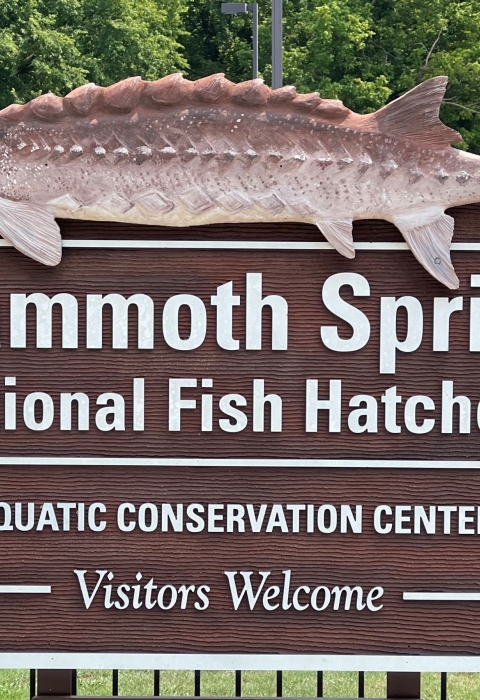Visit Us
At Mammoth Spring National Fish Hatchery (NFH) there is an abundance of activities to participate in, including visiting our Aquatic Conservation Center (ACC) and Aquarium, or attending one of our regular outreach events. While visiting the ACC you can also take a stroll around our hatchery ponds and raceways to check-out the variety of fish being raised here. Fish production at the Hatchery varies depending on the Season and the needs of the Service and our partner agencies. Mammoth Spring NFH is located next to the beautiful Mammoth Spring State Park (home of the world's tenth largest spring) and is mere walking distance from the historic downtown. The Hatchery is also a short drive from Grand Gulf State Park (Missouri's Little Grand Canyon) and the Historic town of Hardy. You can easily make a day full of wonderful memories as you explore the area.
Mammoth Spring NFH is just one of the many field stations of the U.S. Fish and Wildlife Service whose mission is working with others to conserve, protect, and enhance fish, wildlife, and plants and their habitats for the continuing benefit of the American people.
Location and Contact Information
About Us
Since 1871 the National Fish Hatchery system has been at work improving recreational fishing and restoring aquatic species that are in decline, at risk, and are important to the health of our aquatic systems. Across the country the network of National Fish Hatcheries work with states and tribes to conserve, restore and enhance the fish and aquatic resources of America for future generations.
Established in 1903, the Mammoth Spring National Fish Hatchery (NFH), located in Mammoth Spring, Arkansas, just South of the Missouri border about 79 miles northwest of Jonesboro, Arkansas. The hatchery is one of the oldest in the United States and was built in the Ozark foothills in northeast Arkansas due to the availability of the cool flowing water from the world’s tenth largest spring and its easy access to the railroad.
What We Do
Mammoth Spring NFH produces rainbow trout, striped bass, lake sturgeon, walleye, small mouth bass, largemouth bass, golden shiner and thread finned shad. The fish are stocked annually in reservoirs, lakes, rivers and coastal streams across the Legacy Region 4.
Our Organization
Here at Mammoth Spring National Fish Hatchery we raise aquatic species for both recreational and conservation purposes. We also provide outreach and education resources at our Visitor's Center. These events can be scheduled throughout the year. For questions or if you would like to schedule a tour, please contact Rick Peek.
Our Species
Lake sturgeon (Acipenser fulvescens)
Largemouth bass (Micropterus salmoides)
Rabbitsfoot mussel (Quadrula cylindrica cylindrica)
Threadfin Shad (Dorosoma petenense)
Golden Shiner (Notemigonus crysoleucas)
Rainbow Trout (Oncorhynchus mykiss)
Alligator Gar (Atractosteus spatula)
Snuffbox mussel (Epioblasma triquetra)*
Striped Bass (Morone saxatilis)*
Projects and Research
National Fish Hatcheries raise fish and other aquatic species – like crayfish and mussels - to help restore and sustain important fish and other aquatic species for the benefit of the American people. Freshwater mussels play very important roles in our rivers and lakes filtering the water and creating habitat for fish and aquatic insects fish like to eat. With declining fish populations and declining freshwater mussel populations becoming prevalent across the world, fish hatchery operations are more important than ever.

